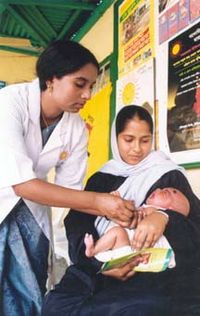
Photo from wikipedia
BACKGROUND/OBJECTIVE Facilitating death preparedness is important for improving cancer patients' quality of death and dying. We aimed to identify factors associated with the four death-preparedness states (no-preparedness, cognitive-only, emotional-only, and… Click to show full abstract
BACKGROUND/OBJECTIVE Facilitating death preparedness is important for improving cancer patients' quality of death and dying. We aimed to identify factors associated with the four death-preparedness states (no-preparedness, cognitive-only, emotional-only, and sufficient-preparedness) focusing on modifiable factors. METHODS In this cohort study, we identified factors associated with 314 Taiwanese cancer patients' death-preparedness states from time-invariant socio-demographics and lagged time-varying modifiable variables, including disease burden, physician prognostic disclosure, patient-family communication on end-of-life (EOL) issues, and perceived social support using hierarchical generalized linear modeling. RESULTS Patients who were male, older, without financial hardship to make ends meet, and suffered lower symptom distress were more likely to be in the emotional-only and sufficient-preparedness states than the no-death-preparedness-state. Younger age (adjusted odds ratio [95% confidence interval] = 0.95 [0.91, 0.99] per year increase in age) and greater functional dependency (1.05 [1.00, 1.11]) were associated with being in the cognitive-only state. Physician prognostic disclosure increased the likelihood of being in the cognitive-only (51.51 [14.01, 189.36]) and sufficient-preparedness (47.42 [10.93, 205.79]) states, whereas higher patient-family communication on EOL issues reduced likelihood for the emotional-only state (0.38 [0.21, 0.69]). Higher perceived social support reduced the likelihood of cognitive-only (0.94 [0.91, 0.98]) but increased the chance of emotional-only (1.09 [1.05, 1.14]) state membership. CONCLUSIONS Death-preparedness states are associated with patients' socio-demographics, disease burden, physician prognostic disclosure, patient-family communication on EOL issues, and perceived social support. Providing accurate prognostic disclosure, adequately managing symptom distress, supporting those with higher functional dependence, promoting empathetic patient-family communication on EOL issues, and enhancing perceived social support may facilitate death preparedness.
Journal Title: Psycho-oncology
Year Published: 2023
Link to full text (if available)
Share on Social Media: Sign Up to like & get
recommendations!